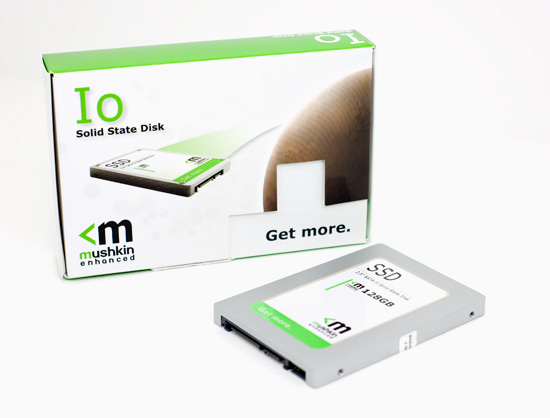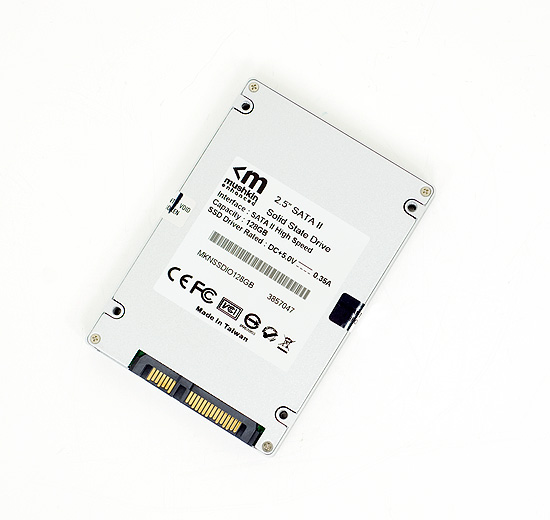OCZ’s Vertex Limited Edition Review & SSD State of the Union
by Anand Lal Shimpi on February 19, 2010 12:00 AM EST- Posted in
- Storage
Indilinx + IMFT 34nm Flash
Meet the G.Skill Falcon II:

It’s uses a standard Indilinx Barefoot controller but is paired with IMFT 34nm flash branded either as Intel or Micron. It’s the same flash that’s used in the X25-M G2s. These drives took a while to come out due to initial incompatibilities between Indilinx’s Barefoot controller firmware and the 34nm flash.

There are no real performance differences because of the new flash, but all of the Indilinx makers are starting to offer lower cost versions of their drives based on it. OCZ’s is called the Solid 2. It’s basically a Vertex but with 34nm IMFT flash. Performance should roughly be the same.
Mushkin - The Newest Indilinx Partner
I've been sitting on this drive for a while, but Mushkin has now started making Indilinx Barefoot drives as well. While SandForce is getting all of the attention these days, Indilinx still has life left and is still on the lookout for partners to build its drives.

Other than sweet looking packaging, the Mushkin Io is identical to all other Indilinx drives:











83 Comments
View All Comments
allessd - Saturday, February 20, 2010 - link
maybe this site is of interest to you:"SSD Decoder Ring - an SSD comparison guide"
www.pcper.com/article.php?aid=736
Jupie - Saturday, February 20, 2010 - link
Great article - always nice to hear about SSDs as I clearly see them as the future for a boot drive at least.What I'm curious about is the performance of drives of the same series with different capacities. I'm not willing to spend ~800 USD on a drive but rather ~400 USD. How much performance hit does a Real SSD C300 really take? Manufactors clearly seem to prefer to send their biggest drives with the highest performance to test but what about the performance of the reasonalbe priced ~100 GB versions?
Would be great to read about that as well ;o)
Otherwise keep up the good articles!
MadMan007 - Saturday, February 20, 2010 - link
Yeah this is an important point, it applies to regular HDs to a much lesser extent too. I would like to see tests on smaller capacity drives of a given series. I guess a lot depends on implentation, for example using the same number of flash chips with a given controller just of a lower capacity per chip versus using fewer flash chips and channels.Conscript - Friday, February 19, 2010 - link
Not sure why I'd pay the premium for "limited" SF-1500 drives when I can just get the same thing here, for less...http://eshop.macsales.com/shop/internal_storage/Me...">http://eshop.macsales.com/shop/internal_storage/Me...
Anand, any chance you think they'd give you one for review? Thinking about putting one of these in my new MBP (when they come out). Unless the new MBP has SATA 3, in which case I might look hard at the C300.
iwodo - Friday, February 19, 2010 - link
May be Anand can do an article on that. You mention previously that controller contribute VERY little to the total cost of SSD. NAND being the major part.If that is the case, then assuming we always need 8 chips for an SSD. SSD Prices wont ever dropped below $100? Because while capacity per unit will grow, it seems minimum unit prices dont fall that much.
icrf - Saturday, February 20, 2010 - link
Yeah, I'd love to see a reliable, slow 8-16 GB drive for $50. I've got a RAID server that can't seem to keep up boot drives and would love something like that.Bolas - Friday, February 19, 2010 - link
So if I'm willing to spend up to $1200 for a boot drive, what's the best option? Crucial? Vertex LE? Intel? OCZ Z-Drive? Something else?czesiu - Friday, February 19, 2010 - link
Any chances for a Kingston SNV425 review?mckirkus - Friday, February 19, 2010 - link
I would like to see what pure RAM drive based storage would do so we can get a sense of how close these drives are getting to some sort of maximum.I'm not sure if you can do this with a RAMDisk you create with software or if and entire image would need to run in RAM (HDTach, etc., will not work on RAM drives for some reason. Just to be clear, I'm not referring to benchmarks of RAM using a SATA interface.
Good stuff yet again Anand.
mindless1 - Friday, February 19, 2010 - link
There is no "sort of maximum", DRAM keeps getting faster.However, if you were to create and use a RAMDISK, however you ended up doing so, it would destroy any flash drive in terms of performance on every possible parameter. The question is not about performance at all, rather the implementation and volatile nature of using it... and of course that it's no small feat to end up with hundreds of GB worth of those chips for typical HDD replacement purposes (in a reasonably sized form factor).